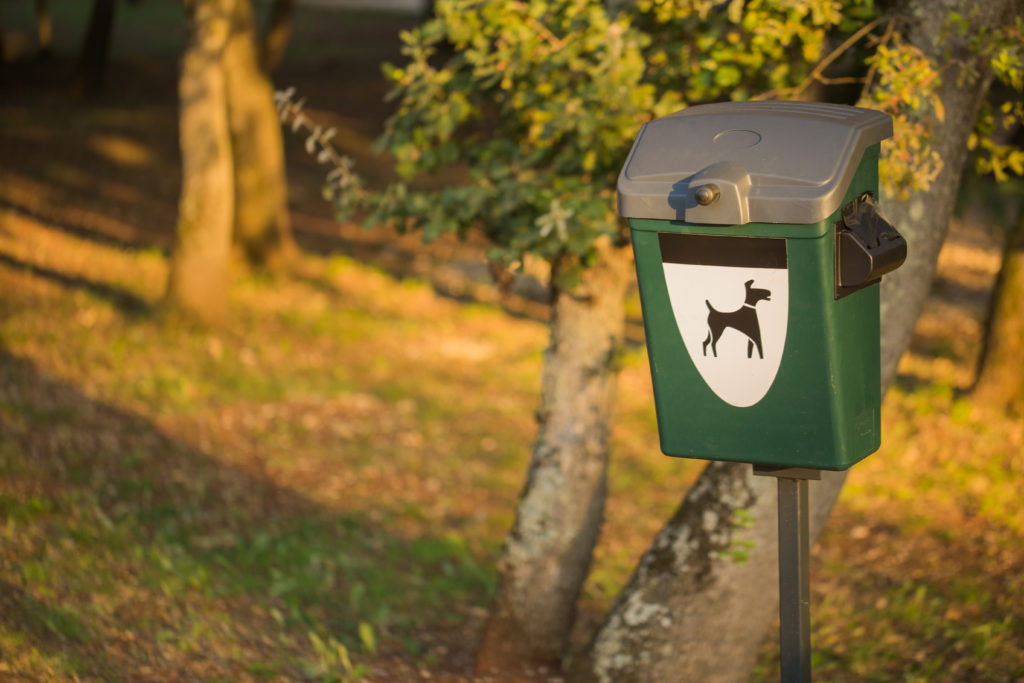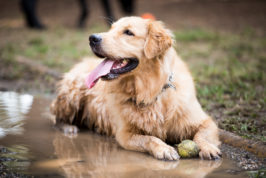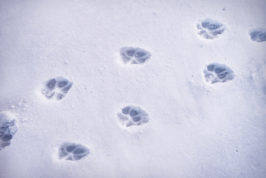Picking up poo isn’t the most glamourous part of being the proud parent of a pooch, but it’s part of the job! One thing’s for sure, when you get up close and personal with your dog’s poo, after a while, you get to know what’s normal for them. This means that if anything about their poo changes, whether it’s the colour, the consistency, or how often they do their business, you’ll be able to spot it. You might not know that the features of your dog’s poo can actually give you information about their health.
So, when it comes to dog poo, what is normal? And what might your dog’s poo be telling you?

What is normal?
Every dog is different, and each has their own unique qualities that make them a treasured companion for their owner. And it’s no different when it comes to their poo – each dog will have their own version of normal. What’s important is getting to know their normal poo so that you can quickly notice any changes that could mean they’re unwell or need a tweak in their diet. If you’re unsure how to keep your dog’s tummy in tip-top condition, read our expert guide on how to keep your dog’s digestive system healthy. about So, what could constitute normal poo? And when might you need to worry?
How often your dog poos will depend on when and what they’re fed. Some dogs get into a predictable routine of passing poo at particular times of day, which can be convenient for their pet parents! However, even if your dog poos like clockwork, if you change their dog food or give them some extra treats, you might notice that they take a few days to get back into a routine. On the other hand, some dogs are naturally more irregular, so just because you can’t predict when your dog will poo doesn’t mean that there is anything wrong.
As a guide, it takes about six to eight hours for your dog’s meal to pass through their guts and out the other side. Therefore, you can expect your adult dog to poo between one and three times a day, depending on how often they are fed. Puppies tend to poo more frequently, though, as they often have more frequent meals.
Normal dog poo consistency can vary, but it should always be formed rather than sloppy, and it shouldn’t be dry or firm. It should be easily passed without too much effort or straining from your pooch. On the other hand, they should have reasonable control over their bowels, so it shouldn’t leak out unexpectedly! The consistency of your dog’s poo shouldn’t vary too much if their diet is constant.
Normal dog poo should be a shade of brown. It can vary between light or dark brown for each dog, but the colour should remain reasonably consistent unless you chop and change their diet.
What isn’t normal? And what does it mean?

If your dog’s poo is usually a certain way, you can consider that to be their normal. So, any difference in the frequency, colour, or consistency and any additional material like blood or mucous could indicate a problem.
Frequency
If your dog suddenly starts passing poo more frequently, even if the consistency is normal, it could mean that their guts are irritated. If you have recently given them some titbits or treats that aren’t part of their regular diet, this could be the cause. It could also be an indication of a dietary intolerance or the beginning of a diarrhoea bug.
If you notice that your dog is not passing poo as regularly, this could indicate constipation. You should watch out for them straining while passing poo and check whether the poo is drier or harder than usual. You might also notice a film of slimy mucous around the solid poo, where it has been sitting in the large bowel for longer than usual.
Consistency
If your dog’s poo becomes less firm, whether it is semi-solid, runny, or purely liquid, this is diarrhoea. Common causes of diarrhoea include food intolerances, infections, pancreatic issues, worms and other parasites. However, diarrhoea can also be a symptom of many other conditions.
If you notice that your dog’s poo has a jelly-like consistency, this often suggests that they have colitis, which is inflammation of the large bowel. Alongside a jelly-like stool, you might notice mucus or even spots of frank (red) blood. Colitis can be caused by a change in diet, fatty or rich treats, or even stress. It’s common for puppies to get colitis during their settling-in period in their new home, but it can happen to any dog at any time.
If your dog’s poo has become hard and dry, they likely have constipation. When the poo sits in the colon for longer than usual, the water from the poo is absorbed, leaving the poo dry, firm and harder to pass. Constipation can be caused by changes in diet, a lack of fibre in the diet, or your dog not drinking enough water.
Chalky poo often suggests that your dog is getting too much calcium or that they are eating too many bones. Chalky poos can also be hard to pass and can lead to constipation.
Colour
If you notice that your dog’s poo is red, either throughout the poo or just sections, this is likely to be blood. It’s understandable and sometimes warranted to be very concerned if you notice blood in your dog’s poo. However, red blood suggests that the area of the gut that is bleeding is low down and likely the large bowel, which is less concerning than black digested blood. Red blood in the stools is most commonly caused by infection, colitis, parasites, or other gut inflammation. However, it can also be caused by tumours or bleeding disorders.
If your dog’s poo is black, or very dark and tarry, this is likely to be digested blood. Digested blood in your dog’s poo means that the blood is from higher up their digestive tract, in their oesophagus, stomach, small intestine, or even their mouth. Digested blood in the stools can indicate a bleeding disorder, infection, stomach ulcer, or tumour, among other things and should always be considered an emergency.
Pale or white poo can indicate problems with digestion or the liver since the brown colour of normal poo is due to bile pigments. If the pale poo is chalky in consistency, it could also mean that your dog’s diet is too high in calcium, or they are eating too many bones.
Yellow-coloured poo often suggests a food intolerance or gut inflammation. If your dog has colitis, their poo will usually be more yellow than normal.
Green dog poo does occasionally happen, although the cause is not always known. It can result from something they have recently eaten, so think back to any treats or titbits that might be the culprit. It can also be a result of eating grass, and if this is the case, you might also notice some undigested blades of grass within the stool. Rarely, green stools signify that a dog has eaten a toxin, like rat poison, so if you can’t quickly identify the cause or your dog is unwell, you should get in touch with a veterinarian.
Urgency
If your dog is usually clean overnight, but you come downstairs in the morning to find poo near the back door, this doesn’t usually mean they’ve forgotten their house training. It’s more likely, especially if they have diarrhoea, that they just couldn’t make it outside in time. This urgency to pass poo is common with diarrhoea and is often caused by infection. Beware, though, that dogs can also pass poo in the house if they have arthritis, back pain, or senile brain changes.
Straining
Straining to pass poo doesn’t always mean that your dog is constipated. Although constipation does cause dogs to have trouble passing hard stools, colitis and other types of diarrhoea can also cause straining. In fact, in many instances, blood in the stool is caused by straining, which causes blood vessels in the rectum to burst.
Mucous
When the colon is inflamed, the cells lining it produce more mucous than usual. So, colitis is the most common cause of mucous within your dog’s poo. If they have colitis, you might also notice that their poo is sloppy or jelly-like, and there might be some spots of red blood.
Mucous doesn’t only turn up in a dog’s poo due to colitis, though. Sometimes, if your dog is constipated, you might notice a lining of mucous surrounding pieces of very hard poo.
Blood
Spots of frank (red) blood in or around your dog’s poo typically indicate colitis. However, very occasionally, it could be due to an anal gland issue or a bleeding lump in or around their bottom.
What to do if your dog’s poo changes

What to feed a dog with diarrhoea
If your dog has diarrhoea but is otherwise well, you can try feeding them a bland diet for forty-eight hours. Examples of bland diets you could use include boiled chicken and rice, white fish, plain pasta, or scrambled eggs without milk. However, if your dog is acting unwell, or if their poo doesn’t improve within forty-eight hours, you should make an appointment to see your veterinarian.
What to do if your dog is constipated
If your dog is constipated but acting normally otherwise, you could try increasing their water intake by wetting their food and offering more water. In the long term, you could try to prevent them from getting constipated by continuing to encourage them to drink more and adding more fibre to their diet. Fibre will draw more water into the poo while in the colon, helping it pass more easily.
If your dog is acting unwell or is straining to poo but not passing anything, you should take them for a check-up with a veterinarian. The veterinarian will be able to check for a blockage and prescribe medication if needed.
When to see a vet
If your dog is off their food, vomiting, or has any other symptoms, it’s essential to speak to your veterinarian before trying any home remedies. You should also make an appointment with a veterinarian if your dog’s poo is black, contains lots of blood, or if they might have eaten something poisonous.
If your dog is well but has diarrhoea or is constipated, you can try adjusting their diet appropriately. However, if they don’t improve quickly or develop any other symptoms, you should seek advice from your veterinarian.
Summary
You might not want to pay too much attention to your dog’s poo; after all, it’s not the most pleasant. But, if you do, you’ll be able to spot the signs of some illnesses and conditions early, which means that you can help keep them as healthy as possible.




